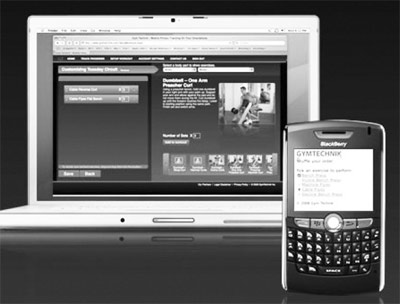Healthy Fit: Get smart(phone) about getting fit

Thanks to Apple's iPhone and RIM's BlackBerry smartphones, we can experience the wonderful world of interactive apps on the fly.
Users have the option of purchasing apps for a small fee or downloading them at no cost. What is becoming very popular on smartphones is the inclusion of more fitness apps.
A growing number of fitness programs are creating their own apps to help people track their workouts, measure or monitor their progress and learn effective tricks and tips to stay on top of their game.
Smartphones are titled as such because they do the thinking for us. Users don't have to travel with a calculator to determine how many calories they consumed or burned. This makes it more convenient and accessible for users on the move.
Fitness apps are programmed with large amounts of data that store multiple workouts, diets and health information that's easily accessible at our fingertips.
Many college students carry mobile phones on campus, but it's almost guaranteed that the majority of them do not have a fitness app installed on their devices.
Fitness apps can help students make informed decisions about their dietary supplements, especially since most of the cafeteria outlets serve fast food. Besides, students are always looking for ways to save a buck or two, and fitness apps are a great way to cut down costs from expensive personal trainers or customized meal plan programs. Fitness apps allow students to create workouts that compliment their schedules and gain control of their health and fitness activities.
Before downloading an app, users are encouraged to read its full description and check the number of reviews and ratings received.
Users also have the option of viewing screenshots of the app to preview the features and its design layout. Once installed, there is an option to uninstall the app, if it falls short of expectations or performance.
Everyone has a different view on what a good app is. These results are based on the more positive reviews shared by users who recommend them to others.
Lose It! is one example of a popular fitness app for the iPhone. This is a weight loss app that is absolutely free. It provides the user with the ability to track food consumption, find out the true nutritional breakdown of all that's eaten and records the exercise that's eaten. It also assists the user by creating realistic goals and maintaining consistent eating habits.
Likewise, for the BlackBerry phone, a popular fitness app is Gym Technik. This is another free app for physical exercise routines. It guides users to set up workouts based on body parts such as arms, shoulders, abs, back and legs. There is also a section for setting up cardio and custom workouts. It features 45 exercises for arms, 23 for the back and eight cardio exercises. Each activity features instructions for correct execution.
Fitness apps on smartphones can cost anywhere from $0.99 to $29.99. These are one-time fees, unlike recurring costs with other workout programs. There isn't much of a difference between free and paid apps, unless one is looking for greater volume of data that requires more disk space, interactivity or simply prefer apps designed by popular brands.
As a new user, free apps are the best way to go as you're still in the experimenting stage.
Smartphone technology is opening doors for companies to engage mobile users in more health and fitness activities. Fitness apps are only the beginning of a "smartphone fit" generation.













